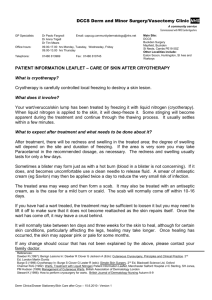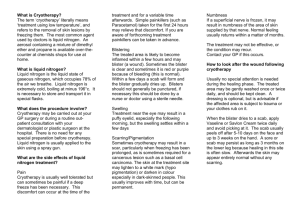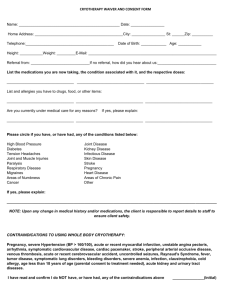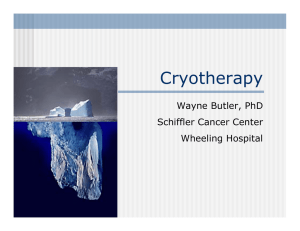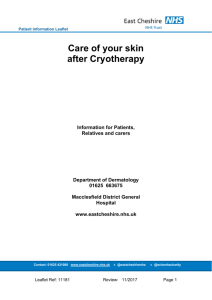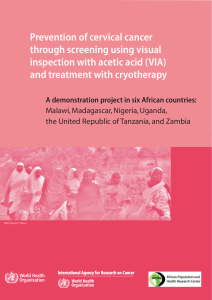CRYOTHERAPY
advertisement
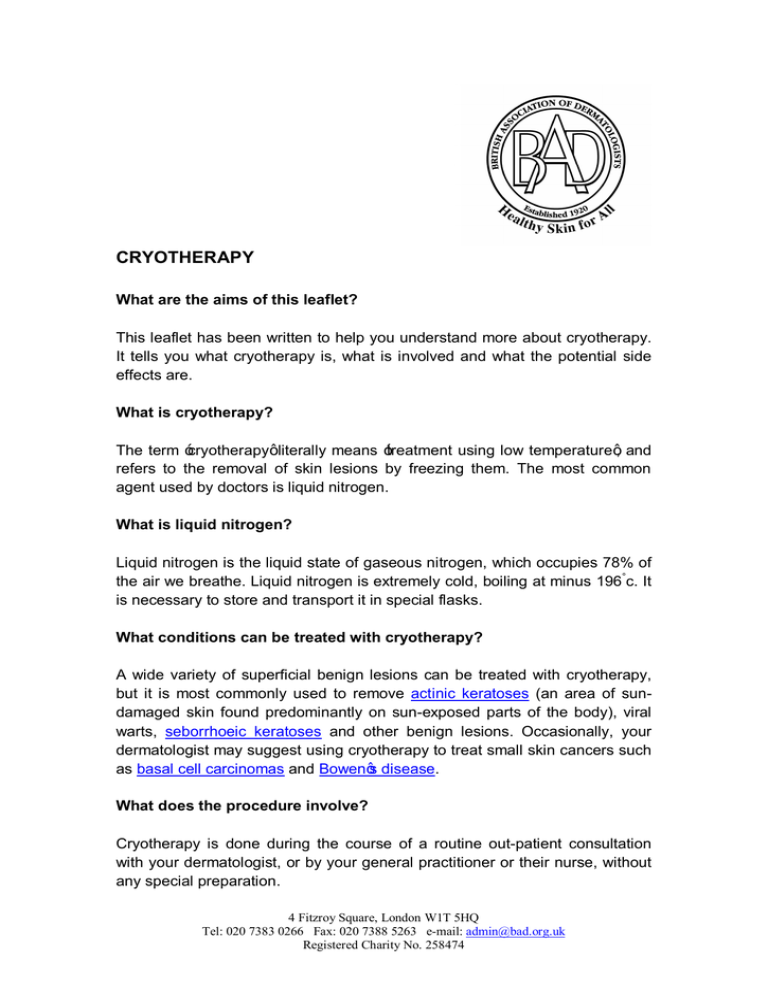
CRYOTHERAPY What are the aims of this leaflet? This leaflet has been written to help you understand more about cryotherapy. It tells you what cryotherapy is, what is involved and what the potential side effects are. What is cryotherapy? The term ‘cryotherapy’ literally means ‘treatment using low temperature’, and refers to the removal of skin lesions by freezing them. The most common agent used by doctors is liquid nitrogen. What is liquid nitrogen? Liquid nitrogen is the liquid state of gaseous nitrogen, which occupies 78% of the air we breathe. Liquid nitrogen is extremely cold, boiling at minus 196°c. It is necessary to store and transport it in special flasks. What conditions can be treated with cryotherapy? A wide variety of superficial benign lesions can be treated with cryotherapy, but it is most commonly used to remove actinic keratoses (an area of sundamaged skin found predominantly on sun-exposed parts of the body), viral warts, seborrhoeic keratoses and other benign lesions. Occasionally, your dermatologist may suggest using cryotherapy to treat small skin cancers such as basal cell carcinomas and Bowen’s disease. What does the procedure involve? Cryotherapy is done during the course of a routine out-patient consultation with your dermatologist, or by your general practitioner or their nurse, without any special preparation. 4 Fitzroy Square, London W1T 5HQ Tel: 020 7383 0266 Fax: 020 7388 5263 e-mail: admin@bad.org.uk Registered Charity No. 258474 Whilst liquid nitrogen is usually applied to the skin by using a spray gun, a metal probe or a cotton bud can sometimes be used instead of the spray gun. Cryotherapy does not normally require a local anaesthetic, and the procedure itself lasts a matter of seconds; the precise time depending on the thickness and size of the lesion. The frozen skin becomes white and takes one to two minutes to thaw to normal skin temperature. Your doctor may suggest that the process is repeated once the skin has thawed out. Over the succeeding few days, a scab will form, and this will take one to two weeks (and occasionally a little longer, especially on the legs) to come away. Usually, the treated area will eventually look normal, although scarring and discolouration is possible, particularly on the legs. Depending on the nature of the lesion, more than one treatment may be necessary, and this is usually repeated at regular intervals. How should the treated area be cared for? Your doctor will explain how s/he would like you to care for the treated areas. It is usually suggested that they are kept dry until a scab forms, and your doctor may suggest that Vaseline is applied. If wetted the scabs should be patted dry with a soft towel or tissue. It is important not to pick at the scab as this will encourage scarring. A dressing or plaster is not usually necessary, but may be advisable if the treated area is prone to being traumatized or rubbed by clothing. What are the side effects of this treatment? Immediate side effects: · Pain - cryotherapy is usually well-tolerated, but can sometimes be painful if a deep freeze has been necessary (i.e. to treat a basal cell carcinoma). This discomfort can occur both at the time of treatment and for a variable time thereafter. Painkillers (such as paracetamol) taken for the first 24 hours may relieve that discomfort; also taking an analgesic an hour or so prior to anticipated treatment can reduce the discomfort. · Swelling and redness - this is a normal immediate response to freezing the skin, and usually settles after two to three days; your doctor may apply a steroid ointment to the treated area to reduce this. For a short while the treated area may ooze a little. Cryotherapy close to the eyes 4 Fitzroy Square, London W1T 5HQ Tel: 020 7383 0266 Fax: 020 7388 5263 e-mail: admin@bad.org.uk Registered Charity No. 258474 · · may induce prominent puffiness of the lower eyelids which settles within days. Blistering - this is also a common consequence of cryotherapy and blisters settle after a few days as the scab forms. Some people blister more easily than others and the development of blisters does not necessarily mean that the skin has been frozen too much. Occasionally the blisters may become filled with blood; this is harmless and only if a blister was very uncomfortable would it be necessary to puncture it, using a sterile needle. Infection - uncommonly, infection can occur, resulting in increased pain and the formation of pus: this may require topical antiseptic or antibiotic therapy. Subsequent side effects: · Scarring - rarely, a scar will form, especially if a deep freeze has been necessary (i.e. to treat a basal cell carcinoma). · Pigmentation changes - the skin at and around the treatment site may lighten or darken in colour, especially in dark-skinned people. This usually improves with time, but may be permanent. · Numbness - if a superficial nerve is frozen, it may result in numbness of the area of skin supplied by that nerve. Normal feeling usually returns within a matter of months. · Treatment may not be effective, or the condition may recur. Where can I get more information about cryotherapy? http://dermnetnz.org/procedures/cryotherapy.html This leaflet aims to provide accurate information about the subject and is a consensus of the views held by representatives of the British Association of Dermatologists: its contents, however, may occasionally differ from the advice given to you by your doctor. This leaflet has been assessed for readability by the British Association of Dermatologists’ Patient Information Lay Review Panel BRITISH ASSOCIATION OF DERMATOLOGISTS PATIENT INFORMATION LEAFLET PRODUCED JULY 2008 UPDATED OCTOBER 2011 REVIEW DATE OCTOBER 2014 4 Fitzroy Square, London W1T 5HQ Tel: 020 7383 0266 Fax: 020 7388 5263 e-mail: admin@bad.org.uk Registered Charity No. 258474
